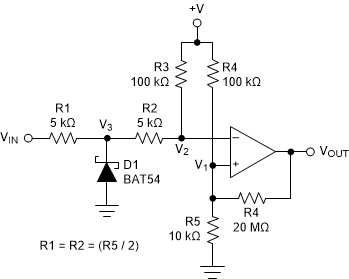SNOSDJ3 May 2024 TLV1812-EP
ADVANCE INFORMATION
- 1
- 1Features
- 2Applications
- 3Description
- Pin Configuration and Functions
- 4Specifications
- 5Detailed Description
-
6Application and Implementation
- 6.1 Application Information
- 6.2 Typical Applications
- 6.3 Power Supply Recommendations
- 6.4 Layout
- 7Device and Documentation Support
- 8Revision History
- 9Mechanical, Packaging, and Orderable Information
6.2.8 Zero Crossing Detector
 Figure 6-17 Zero Crossing Detector
Figure 6-17 Zero Crossing DetectorA voltage divider of R4 and R5 establishes a reference voltage V1 at the non-inverting input. By making the series resistance of R1 and R2 equal to R5, the comparator will switch when VIN = 0. Diode D1 insures that V3 clamps near ground. The voltage divider of R2 and R3 then prevents V2 from going below ground. A small amount of hysteresis is setup to ensure rapid output voltage transitions.